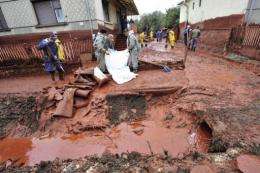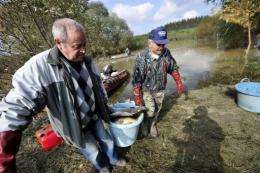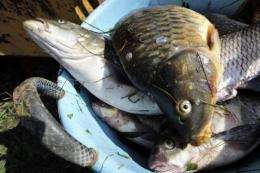Hungary toxic sludge spill reaches Danube (Update)

The company at the centre of Hungary's toxic sludge leak that killed four people defended itself Friday, as fears increased over the threat to marine life in Europe's second longest river.
In a statement on its website, MAL Hungarian Aluminium Production and Trade Company said that it had released aid of 30 million HUF, (110,000 euros, 150,000 dollars) to local authorities to help deal with the disaster.
According to the mayor of one of the villages worst hit by the sludge, the sum would go to payments of 360 euros (504 dollars) to each family affected by the leak.
In its statement, the company also offered its condolences to the relatives of the four people who had lost their lives and said it would cover their funeral expenses.
MAL has come under fierce criticism, with officials suggesting too much of the caustic red sludge was contained in the reservoir, but the company insists it has done nothing wrong.
It said it was devoting "all its energies and efforts" to alleviating the effects of the spill.
The Open Society Foundation set up by financier George Soros announced Thursday it was donating a million dollars to the victims of the spill.
Officials in Hungary and beyond, downriver of the disaster, followed the progress of the blood-red sludge with increasing concern.
The pollution reached the main branch of the Danube at around midday (1000 GMT) Thursday, after wiping out all life in the smaller Marcal tributary, said Tibor Dobson, the regional chief of Hungary's disaster relief services.
"I can confirm that we have seen sporadic losses of fish in the main branch of the Danube," Dobson said.
"The fish have been sighted at the confluence of the Raba with the Danube," where water samples had shown a pH value of 9.1, he said.
"In order to save the river's ecosystem, the pH level must be brought down below 8," Dobson said.

Water alkalinity is a measure of river contamination and on a scale of 1-14, pH values of 1-6 are acid, between 6 and 8 are neutral, and readings of 8-14 are alkaline.
Dobson said that pH values of 9.6 had been measured in the Raba, a tributary of the Danube, up from earlier in the day; and 9.4 in the Danube's Mosoni branch.
In the village of Gyirmot, where the Marcal flows into the Raba, volunteers collected bucketfuls of dead fish from the stinking water.
The toxic spill poured from a reservoir at an aluminium plant in Ajka, 160 kilometres (100 miles) west of Budapest, which burst Monday, sending 1.1 million cubic metres (38.8 million cubic feet) of red sludge into surrounding villages.
Four people died in one of the villages, Kolontar, from where the tiny Torna stream flows into the Marcal, a tributary of the Raba, which in turn flows into the Danube.
The Danube runs from Hungary through Croatia, Serbia, Bulgaria, Romania and Ukraine to the Black Sea.
Serbia, Croatia and Romania said they were stepping up monitoring of the river given the risk of drinking water contamination in towns along the river.
Adrian Draghici, head of the water management authority in Mehedinti county, 400 kilometres west of Bucharest, said the pollution could reach Romania Saturday.

But a Hungarian water official played down the long-term impact of the pollution, saying it would only affect a limited part of the Danube.
"Alkaline levels show that the pollution will probably not have an effect on the Danube's ecosystem below Komarom," Emil Janak, the director of the regional water authority, was quoted as saying by MTI news agency.
The city of Komarom is 20 kilometres downstream of the point where the Raba flows into the Danube, and 80 kilometres upsteam of Budapest.
Environmentalists expressed alarm about the possible long-term effects of the disaster.
"The heavy metals are the danger in the long run," Gabor Figeczky, acting head of nature protection body the WWF in Hungary, told AFP.
The Marcal's ecosystem could take between three and five years to recover, he added.
Prime Minister Viktor Orban earlier visited Kolontar, and said it may have to rebuilt elsewhere because the ground was uninhabitable.
He insisted Hungary did not need financial help, but would welcome expertise to help clean up the spill.
In Brussels, the European Commission said Hungary had requested the dispatch of three to five experts in cleaning up toxic spills under the bloc's joint civil protection assistance measures.
(c) 2010 AFP





















